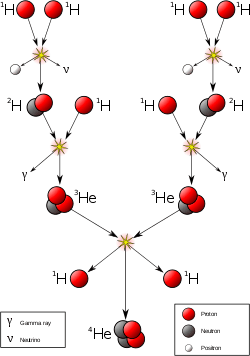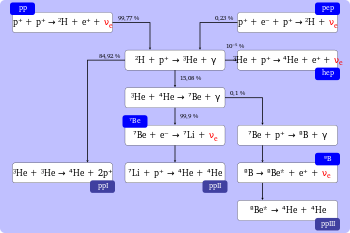Proton–proton chain reaction

The proton–proton chain reaction is one of two known sets of nuclear fusion reactions by which stars convert hydrogen to helium. It dominates in stars with masses less than or equal to that of the Sun's,[1] whereas the CNO cycle, the other known reaction, is suggested by theoretical models to dominate in stars with masses greater than about 1.3 times that of the Sun's.[2]
In general, proton–proton fusion can occur only if the kinetic energy (i.e. temperature) of the protons is high enough to overcome their mutual electrostatic or Coulomb repulsion.[3]
In the Sun, deuterium-producing events are rare. Diprotons are the much more common result of proton–proton reactions within the star, and diprotons almost immediately decay back into two protons. Since the conversion of hydrogen to helium is slow, the complete conversion of the hydrogen in the core of the Sun is calculated to take more than ten billion years.[4]
Although often called the "proton-proton chain reaction", it is not a chain reaction in the normal sense of the word (at least not Branch I — in Branches II and III helium, which is the product, also serves as a catalyst). It does not produce particles that go on to induce the reaction to continue (such as neutrons given off during fission). In fact, the rate is self-limiting because the heat produced tends toward reducing the density. It is however a chain (like a decay chain) and a reaction, or more accurately a branched chain of reactions starting with two protons coming together and yielding deuterium.
History of the theory
The theory that proton–proton reactions are the basic principle by which the Sun and other stars burn was advocated by Arthur Eddington in the 1920s. At the time, the temperature of the Sun was considered to be too low to overcome the Coulomb barrier. After the development of quantum mechanics, it was discovered that tunneling of the wavefunctions of the protons through the repulsive barrier allows for fusion at a lower temperature than the classical prediction.
Even so, it was unclear how proton–proton fusion might proceed, because the most obvious product, helium-2 (diproton), is unstable and almost instantly dissociates back into two protons. In 1939, Hans Bethe proposed that one of the protons could decay by beta emission into a neutron via the weak interaction during the brief moment of fusion, making deuterium a vital product in the chain.[5] This idea was part of the body of work in stellar nucleosynthesis for which Bethe won the Nobel Prize in Physics in 1967.
The proton–proton chain reaction
The first step involves the fusion of two 1
H
nuclei (protons) into deuterium, releasing a positron and a neutrino as one proton changes into a neutron. It is a two-stage process; first, two protons fuse to form a diproton:
followed by the beta-plus decay of the diproton to deuterium:
with the overall formula:
This second step is extremely slow because the positron emission of the diproton to deuterium is extremely rare (the vast majority of the time, the diproton decays back into two hydrogen-1 unbound protons through proton emission). This is because the emission of the positron is brought about by the weak nuclear force, which is immensely weaker than the strong nuclear force and the electromagnetic force.
The half-life of a proton in the core of the Sun before it is involved in a successful proton–proton fusion is estimated to be about one billion years, even at the extreme pressures and temperatures found there.
The positron emitted by the decay by beta emission usually annihilates immediately with an electron. Their mass-energies plus their kinetic energy is carried off by two gamma rays (photons) with the mass-energy of 511 keV (thousand electron-volts) apiece.
After it is formed, the deuterium produced in the first stage can fuse with another proton to produce the light isotope of helium, 3
He
:
This process, mediated by the strong nuclear force rather than the weak force, is extremely fast by comparison to the first step. It is estimated that, under the conditions in the Sun's core, each newly created deuterium nucleus exists for only about four seconds before it is converted to He-3.
In the Sun, each helium-3 nucleus produced in these reactions exists for only about 400 years before it is converted into helium-4.[6] Once the helium-3 has been produced, there are four possible paths to generate 4
He
. In p-p I, helium-4 is produced by fusing two helium-3 nuclei; the p-p II and p-p III branches fuse 3
He
with pre-existing 4
He
to form beryllium-7, which undergoes further reactions to produce two helium-4 nuclei.
In the Sun, 4
He
synthesis via branch p-p I occurs with a frequency of 83.30 percent, p-p II with 16.68 percent, and p-p III with 0.02 percent.[7]
There is also the extremely rare p-p IV branch. Other even-rarer reactions may occur. The rate of these reactions is very low due to very small cross-sections, or because the number of reacting particles is so low that any reactions that might happen are statistically insignificant. This is partly why no mass-5 or mass-8 elements are seen. While the reactions that would produce them, such as a proton + helium-4 producing lithium-5, or two helium-4 nuclei coming together to form beryllium-8, may actually happen, these elements are not detected because there are no stable isotopes of atomic masses 5 or 8; the resulting products immediately decay into their initial reactants.
The overall reaction is:
4p → 4
He
+ 2e+ + 2νe
The P-P I branch
The complete p-p I chain reaction releases a net energy of 26.732 MeV.[8] Two percent of this energy is lost to the neutrinos that are produced.[9]
The p-p I branch is dominant at temperatures of 10 to 14 MK.
Below 10 MK, the P-P chain does not produce much 4
He
.
The P-P II branch

The P-P II branch is dominant at temperatures of 14 to 23 MK.
Note that the energies in the equation above are not the energy released by the reaction. Rather, they are the energies of the neutrinos that are produced by the reaction. 90 percent of the neutrinos produced in the reaction of 7
Be
to 7
Li
carry an energy of 0.861 MeV, while the remaining 10 percent carry 0.383 MeV. The difference is whether the lithium-7 produced is in the ground state or an excited (metastable) state, respectively.
The P-P III branch

The P-P III chain is dominant if the temperature exceeds 23 MK.
The p-p III chain is not a major source of energy in the Sun (only 0.11 percent), but it was very important in the solar neutrino problem because it generates very high energy neutrinos (up to 14.06 MeV).
The P-P IV (Hep) branch
This reaction is predicted theoretically, but it has never been observed due to its rarity (about 0.3 ppm in the Sun). In this reaction, helium-3 captures a proton directly to give helium-4, with an even higher possible neutrino energy (up to 18.8 MeV).
Energy release
Comparing the mass of the final helium-4 atom with the masses of the four protons reveals that 0.7 percent of the mass of the original protons has been lost. This mass has been converted into energy, in the form of gamma rays and neutrinos released during each of the individual reactions. The total energy yield of one whole chain is 26.73 MeV.
Energy released as gamma rays will interact with electrons and protons and heat the interior of the Sun. Also kinetic energy of fusion products (e.g. of the two protons and the 4
2He
from the p-p I reaction) increases the temperature of plasma in the Sun. This heating supports the Sun and prevents it from collapsing under its own weight.
Neutrinos do not interact significantly with matter and therefore do not help support the Sun against gravitational collapse. Their energy is lost: the neutrinos in the p-p I, p-p II, and p-p III chains carry away 2.0%, 4.0%, and 28.3% of the energy in those reactions, respectively.[10]
The PEP reaction

Deuterium can also be produced by the rare pep (proton–electron–proton) reaction (electron capture):
In the Sun, the frequency ratio of the pep reaction versus the p-p reaction is 1:400. However, the neutrinos released by the pep reaction are far more energetic: while neutrinos produced in the first step of the p-p reaction range in energy up to 0.42 MeV, the pep reaction produces sharp-energy-line neutrinos of 1.44 MeV. Detection of solar neutrinos from this reaction were reported by the Borexino collaboration in 2012.[11]
Both the pep and p-p reactions can be seen as two different Feynman representations of the same basic interaction, where the electron passes to the right side of the reaction as a positron. This is represented in the figure of proton–proton and electron-capture chain reactions in a star, available at the NDM'06 web site.[12]
See also
| Wikimedia Commons has media related to Proton-proton chain reaction. |
References
- ↑ "The Proton-Proton Chain". Astronomy 162: Stars, Galaxies, and Cosmology. Archived from the original on 2016-06-20. Retrieved 2018-07-30.
- ↑ Salaris, Maurizio; Cassisi, Santi (2005). Evolution of Stars and Stellar Populations. John Wiley and Sons. pp. 119–121. ISBN 0-470-09220-3.
- ↑ Ishfaq Ahmad, The Nucleus, 1: 42, 59, (1971), The Proton type-nuclear fission reaction.
- ↑ Kenneth S. Krane, Introductory Nuclear Physics, Wiley, 1987, p. 537.
- ↑ Hans A. Bethe, Physical Review 55:103, 434 (1939); cited in Donald D. Clayton, Principles of Stellar Evolution and Nucleosynthesis, The University of Chicago Press, 1983, p. 366.
- ↑ This time and the two other times above come from: Byrne, J. Neutrons, Nuclei, and Matter, Dover Publications, Mineola, NY, 2011, ISBN 0486482383, p 8.
- ↑ Adelberger, Eric G.; et al. (12 April 2011). "Solar fusion cross sections. II. The pp chain and CNO cycles". Reviews of Modern Physics. 83 (1): 201. arXiv:1004.2318. Bibcode:2011RvMP...83..195A. doi:10.1103/RevModPhys.83.195.
- ↑ LeBlanc, Francis. An Introduction to Stellar Astrophysics.
- ↑ Burbidge, E.; Burbidge, G.; Fowler, William; Hoyle, F. (1 October 1957). "Synthesis of the Elements in Stars". Reviews of Modern Physics. 29 (4): 547–650. Bibcode:1957RvMP...29..547B. doi:10.1103/RevModPhys.29.547. This value excludes the 2% neutrino energy loss.
- ↑ Claus E. Rolfs and William S. Rodney, Cauldrons in the Cosmos, The University of Chicago Press, 1988, p. 354.
- ↑ Bellini, G.; et al. (2 February 2012). "First Evidence of pep Solar Neutrinos by Direct Detection in Borexino". Physical Review Letters. 108 (5): 051302. arXiv:1110.3230. Bibcode:2012PhRvL.108e1302B. doi:10.1103/PhysRevLett.108.051302. PMID 22400925.
- ↑ Int'l Conference on Neutrino and Dark Matter, Thursday 07 Sept 2006, http://indico.lal.in2p3.fr/getFile.py/access?contribId=s16t1&sessionId=s16&resId=1&materialId=0&confId=a05162 Session 14.